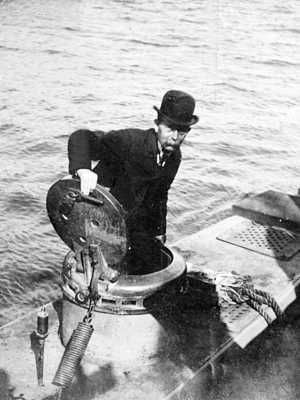 (source)
(source)
|
John Philip Holland
(29 Feb 1840 - 12 Aug 1914)
Irish inventor who has been called the “father of the modern submarine.” He designed and built the first successful submarine, Fenian Ram (1875). After improvements, he received a contract from by the U.S. Navy (1895).
|
Mr. Holland’s Little Demon.
Launched Through a Shop Window and Taken to Pamrapo for Experiment.
Since September, 1882, a sign has been displayed on the door of an upper room in Thomas Gannon’s brass foundry, Jersey City. It read: “Positively no Admittance. This Means You.” Within the room workmen were building a working model of a submarine torpedo boat invented by John Philip Holland. On account of its small size not more than two men could work on it at once, and they dragged along until last week, when it was completed.
Yesterday the door was opened and a Sun reporter watched half a dozen men launching the new vessel out of the front window and down a pair of skids to a wagon waiting in the street below. The new craft is what is commonly but untruthfully called cigar-shaped. It is the exact shape of the double-cone fishline bobs. It is 16 feet 9 inches in diameter. The shell contains six strakes of boiler iron, the of upper strakes being three-sixteenths inch thick and the bottom strakes an one-quarter of an inch. It is stiffened with six rings of T iron. Under both the bow and the stern are keels, four and a half feet long, the one under the bow being made of lead and weighing 218 pounds. The rudder is hung to the stern keel. On each side of the rudder is a horizontal rudder or fin, that works on the principle of a balance rudder. The two work together. When the forward ends of these rudders are raised while the vessel goes through the water they naturally elevate the stern of the vessel and depress its nose, causing it to dive under the water. When they are held in that position and the empty compartments made for the purpose are filled with water, the vessel will remain below the surface. For the present the new boat will be propelled by a wheel 18 inches in diameter, with 24 inches pitch. The wheel will be turned by a treadle until Mr. Holland completes a new chemical engine.
On the top of the vessel, one-third of the way forward, is hinged a circular dome of cast iron. A ring of rubber makes an airtight joint when the dome is secured. There are nine skylights in the dome, each about one by two inches. A small iron trough runs forward from the dome over the middle third of the vessel’s length. It contains an iron pipe, and is a part of the apparatus for handling the torpedo. The displacement of the vessel, loaded, is 2,800 pounds.
The craft contains a number of new ideas not utilized in the one made at the Delamater Iron Works in 1881. Just what these improvements are Mr. Holland declines to say, because they have not yet been patented, but they include methods for handling torpedoes and supplying fresh air to those within. With the treadle power Mr. Holland says he can reach a speed of from three to four knots an hour. When the new engine is in place he thinks the speed for very short distances will be as high as ten knots.
This is Mr. Holland’s third working model. The first was completed in 1878. Speaking of it and his work on the others he said: “The first one was successful, although the engines did not work. It demonstrated that a submarine vessel could be handles. We worked it by taking steam through a hose from a steam launch. The next one I got from the Delamater Works, April 19, 1881. I took it to the docks of Mr. Vanderbilt Morris, at Fort Hamilton, where I kept it ten months. He witnessed my experiments with it. I have traveled all over the lower bay beneath the water. We ran her into mud banks at full speed; she always rebounded. We were fifty feet below the surface at times. I have been down under water as long as two and a half hours. That is much longer than would be necessary in warfare. Half an hour or fifteen minutes would enable one to travel the necessary distance to fix a torpedo to a vessel’s keel. We demonstrated that this could be done by actual experiment. The papers had a good laugh over what they thought was a failure. I was an Irishman and kept my secrets to myself. That was conclusive evidence of Fenianism. It was at once decided that I was building a boat to encourage servant girls to contribute to the skirmishing fund. The fact is, I do not belong to any society, and do not want to do so. I have gone into this on business principles. When my experiments are complete and the value of certain ideas is determined, I will be looking for capitalists to form a stock company to build these vessels.”
“Have you ever had any accidents under water?”
“My engineer, George M. Richards, did. He made a dive under a tug near the dock as he was putting out into the river. He left the manhole open, and, of course, she filled. The men on the tug picked him up as he floated out. He was unconscious for ten minutes. When these vessels are properly secured before starting there is no danger, because a man must attend to business to keep them down. If his hand slips or he forgets himself for a minute the boat will rise to the surface.”
The new boat was taken to Pamrapo, where the old one is. The experiments will be made at Pat McGeihan’s shipyard.
[This submarine was a scaled-down experimental model based on Holland’s earlier Fenian Ram submarine. In Nov 1883, both were seized by the Fenian Brotherhood, which had funded them, but had become concerned how their money was being spent. They were towed away, during which the smaller submarine took on water and sank 110-feet in the Long Island Sound. To date, it has never been recovered. —Webmaster.]
- 29 Feb - short biography, births, deaths and events on date of Holland's birth.
- The Inventor of the Submarine - John Philip Holland
- John P. Holland, 1841-1914: Inventor of the Modern Submarine, by Richard Knowles Morris. - book suggestion.





